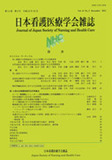Japanese
English
- 有料閲覧
- Abstract 文献概要
- 参考文献 Reference
- サイト内被引用 Cited by
要旨
目的:本研究は、生理的・心理的側面から、笑い刺激が自律神経系に与える影響とその持続効果を検討することを目的とした。
方法:2009年3月2日〜13日にN病院で実施した「運動生理学的視点からみた“笑い”の効果に関する研究」と共同で行った。対象は、N病院の20〜40歳女性で同意を得られた10名とした。生理的指標として、唾液アミラーゼ活性、血圧、心拍数、HRVを用い、心理的指標として、日本語版POMS、フェイススケールを用いた。実験は2日間にわけ、1日目の介入条件では課題の笑いDVDの鑑賞、2日目の対照条件では青い画面を注視してもらった。
結果:介入条件において、唾液アミラーゼ活性は、課題前安静から課題後10分に有意に減少し、課題後20分には課題前安静の値に近づいた。心拍数は、課題開始直前の3分間の平均値と比較して、課題中、課題後10分で有意に上昇した。POMSの「緊張‐不安」、「抑うつ‐落込み」、「怒り‐敵意」、「疲労」、「総合感情障害指標」は、課題実施後に有意な減少がみられた。また、フェイススケールにおいても課題実施後に有意な減少がみられた。両条件の課題実施後において、POMSの「混乱」に有意な減少がみられた。
結論:笑い刺激の自律神経系への影響として、生理的指標の変化からは、交感神経系の活性は笑い刺激の最中に起こり、その後、入れ替わるように副交感神経系が亢進し抑制されていくことが示唆された。そして、心理的指標からは、笑い刺激を受けた20分後もネガティブ感情の低下や気分が良くなるなどの持続効果が認められた。
Abstract
Purpose: The aim of this study was to investigate the effect of laughter stimuli on the autonomic nervous system, and its sustained effect, from both physiological and psychological aspects.
Methods: This study was done together with the "Study on the effect of laughter from the kinesiological perspective" conducted in one hospital during March 2-13, 2009. The participants were 10 female participants(20-40 years old)in the hospital from whom consent was obtained. The physiological indicators were salivary amylase, blood pressure, heart rate, and HRV, while the psychological indicators used were the profile of mood status(POMS)test and a face scale. The experiment was divided into two days. On the first day, the intervention task was for participants to view a comedy DVD, while on the control second day they were asked to gaze at a blue screen.
Results: During the intervention, salivary amylase decreased significantly from the resting state before the task until 10 min after the task. Twenty min after the task, the level had returned to near the pre-task resting level. In the control no significant change was seen. For heart rate the baseline level was taken to be the mean level over the 3 min immediately preceding the start of the task, compared to which it was significantly elevated during and 10 min after the task in the intervention. The "Tension-Anxiety", "Depression-dejection", "Anger-Hostility", "Fatigue-Inertia", and "Total Mood Disturbance" subscales on the POMS showed significant decreases after the task in the intervention only. The face scale showed a significant decrease only after the intervention task. The "Confusion- Bewilderment" showed significant decreases after the task in the intervention both intervention and control.
Conclusion: As for the effects of laughter stimuli on the autonomic nervous system, it was suggested from the changes in physiological indictors that activation of the sympathetic nervous system occurs during laughter stimuli, after which there is a switch to enhancement and then inhibition of the parasympathetic nervous system. Moreover the psychological indicators showed that even 20 min after the laughter stimuli there was a sustained effect with decreased negative feelings and improved mood.
Copyright © 2012, Japan Society of Nursing and Health Care All rights reserved.


